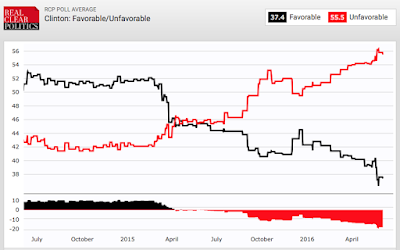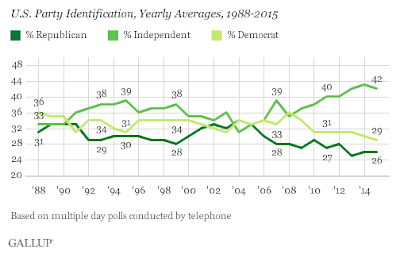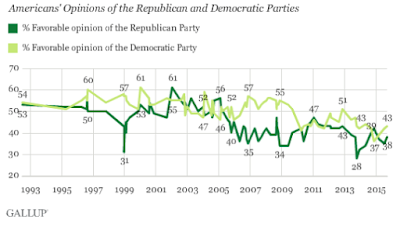With the 2016 primary pretty much over, it's interesting to see that a significant portion of Americans from both sides of the political spectrum are completely disenchanted with their current choices for president and their political party of choice. A Gallup poll from early 2016 may help explain why we see favourable/unfavourable polling like this for Hillary Clinton:
…and find that Donald Trump currently has a favourable rating from 34.1 percent of the electorate and an unfavourable rating from 58.4 percent of the electorate, resulting in a spread of -24.3 percent compared to Hillary Clinton's -18.1 percent. In both cases, the remaining two candidates hardly have anything to be proud of given that they are seen by a minority of American voters as an acceptable presidential candidate.
The Gallup poll explains at least some of this political disenchantment. Of the 12,137 adults polled, only 29 percent identified as Democrats and 26 percent identified as Republicans. This leaves 42 percent of American adults identifying themselves as political independents. This is the fifth consecutive year that 40 percent or more of American voters have identified themselves as independents which, as you can see on this graph, leaves those who identify themselves as Democrats and Republicans at (Democrats) or near (Republicans) record lows going back to the late 1980s:
This rise in political independence is related to growing voter frustration with the Congressional/Presidential gridlock in Washington. A poll by Gallup in early 2016 showed that 16 percent of those polled felt that "government" was the top U.S. problem for the second straight year, ahead of the economy which was the biggest problem for only 13 percent of those polled. Here is a graph showing how Congressional job approval has declined substantially since 2009 and how it remains close to seven year lows:
As well, party favourability rankings are very low with only 43 percent of Americans viewing the Democratic Party favourably and only 38 percent viewing the Republican Party favourably as shown on this graph which shows political party favourability going back to 1993:
The upside of the growing move toward political independence actually seems to favour both sides of the political spectrum equally. When those who declared themselves as independents were asked whether they lean toward the political right or left, an additional 16 percent said that they favoured the Democrats for a combined total of 45 percent. An additional 16 percent said that they favoured the Republicans for a combined total of 42 percent.
All of this political dissatisfaction has led to the rise of two candidates that represented something different; Bernie Sanders and Donald Trump. Both candidates have stood firmly against the puppeteers that are now marginally in control of their respective political parties, much to the delight of a significant portion of Americans who, for the first time in decades, have actually seen that there are millions of voters who agree that the current partisan system is broken.
Click HERE to read more of Glen Asher's columns
You can publish this article on your website as long as you provide a link back to this page.





Be the first to comment